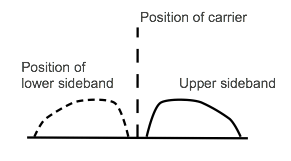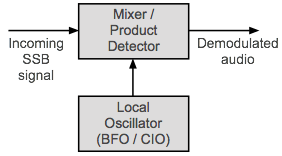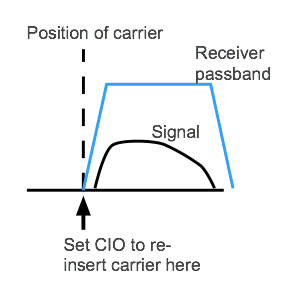Single Sideband Modulation, SSB Demodulation
SSB demodulation is a key to its successful use and application.
Home » Radio & RF technology » this page
Amplitude Modulation, AM Tutorial Includes:
Amplitude modulation, AM
AM basic theory & formulas
AM bandwidth & sidebands
Modulation index & depth
AM efficiency
AM demodulation / detection
Diode detector
Synchronous detector
AM modulators
Single sideband, SSB
SSB demodulation
Modulation formats:
Modulation types & techniques
Frequency modulation
Phase modulation
Quadrature amplitude modulation
SSB, single sideband is easily demodulated, but requires a little more circuitry than is needed for a basic AM envelope detector.
To demodulate SSB transmissions a beat frequency oscillator or carrier insertion oscillator is used along with a mixer or product detector.
SSB demodulation basics
As described in previous pages, single sideband is a form of amplitude modulation where the carrier and one sideband have been suppressed or reduced in level.

In order to demodulate single sideband, SSB, it is necessary to reintroduce the carrier. To achieve this two main elements are required:
- Local oscillator: The local oscillator signal is needed to provide the locally produced carrier signal to re-introduce into the signal. When used in conjunction with SSB demodulation the local oscillator may be referred to by other names:
- Beat frequency oscillator, BFO: This term dates back to the time when a local oscillator was used to produce a beat note when used with Morse code. The same type of oscillator was used for SSB demodulation and the term persisted.
- Carrier insertion oscillator, CIO: This name is very self explanatory and indicates it is used to re-insert the carrier. It is a more correct term than BFO, but not was widely used.
- Mixer: The mixer is used to mix the local oscillator signal and the incoming single sideband signal together. The output from the mixer is the demodulated audio signal.
- Product detector: This term emanates from the fact that the output is a product of the inputs – exactly what is required for SSB demodulation. Producing a product or multiplication of the value of the inputs is the function of a mixer, but the term product detector was used in the early days of the use of SSB, and has remained in use, although it is less widely used than it was previously.

Receiving SSB
When receiving SSB it is necessary to have a basic understanding of how a receiver works. Most radio receivers that will be used to receive SSB modulation will be of the superheterodyne type. Here the incoming signals are converted down to a fixed intermediate frequency. It is at this stage where the BFO signal is mixed with the incoming SSB signals.

It is necessary to set the BFO to the correct frequency to receive the form of SSB, either LSB or USB, that is expected. Many radio receivers will have a switch to select this, other receivers will have a BFO pitch control which effectively controls the frequency. The BFO needs to be positioned to be in the correct position for when the signal is in the centre of the receiver passband. This typically means that it will be on the side of the passband of the receiver. To position the BFO, tune the SSB signal in for the optimum strength, i.e. ensure it is in the centre of the passband, and then adjust the BFO frequency for the correct pitch of the signal. Once this has been done, then the main tuning control of the receiver can be used, and once a signal is audible with the correct pitch, then it is also in the centre of the receiver passband.
Tuning an SSB signal with the BFO set is quite easy. First set the receiver to the SSB position or the BFO to ON, and then if there is a separate switch set the LSB / USB switch to the format that is expected and then gradually tune the receiver. Adjust the main tuning control so that the pitch is correct, and the signal should be comprehensible. If it is not possible to distinguish the sounds, then set the LSB / USB switch to the other position and re-adjust the main tuning control if necessary to return the signal to the correct pitch, at which point the signal should be understandable..
With a little practice it should be possible to easily tune in SSB signals.
 Written by Ian Poole .
Written by Ian Poole .
Experienced electronics engineer and author.
More Essential Radio Topics:
Radio Signals
Modulation types & techniques
Amplitude modulation
Frequency modulation
OFDM
RF mixing
Phase locked loops
Frequency synthesizers
Passive intermodulation
RF attenuators
RF filters
RF circulator
Radio receiver types
Superhet radio
Receiver selectivity
Receiver sensitivity
Receiver strong signal handling
Receiver dynamic range
Return to Radio topics menu . . .



